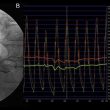Endovascular treatment of lesions in femoropopliteal territory (FPA) has become the main therapeutic option, seeing as it is less invasive and has faster recovery. It has used different devices, such as conventional bare metal stents (BMS), balloon angioplasty (POBA), and drug coated balloons (DCB), as well as drug eluting stents (DES). However, real world data...
What Is the Prognosis of an Acute Myocardial Infarction in the Presence of Moderate Aortic Stenosis?
Aortic stenosis (AS) is a common condition that shares risk factors with coronary artery disease. Many patients can suffer from both diseases simultaneously, something that increases the risk of acute myocardial infarction in the presence of aortic stenosis. AS can cause ischemia even in the absence of coronary artery disease, due to ventricular hypertrophy, increased...
TAVR Durability at 5 Years in Intermediate Risk Patients
TAVR has been shown beneficial in patients across the risk spectrum. The PARTNER 2 SAPIEN 3 (P2S3i) study on intermediate risk patients was the first to show TAVR superiority vs SAVR when using the transfemoral approach. SAVR durability has been shown in different analysis but, except for a few reports, TAVR durability at long term...
Is Edge-to-Edge Treatment with PASCAL Effective at 3 Years?
Mitral regurgitation is the most common valvular heart disease. Its cause is most frequently functional or secondary dysfunction (functional mitral regurgitation, FMR) compared with degenerative mitral regurgitation (DMR), which is associated with decreased ventricular function, hospitalization for heart failure, and mortality. While medical treatment is effective over extended periods, a significant number of patients cannot...
We Should Revascularize Patients with Stable Coronary Syndromes and Ischemia Assessed by iFR
Chronic stable angina has shown a good response to medical treatment, and the Ischemia study has recently demonstrated the safety of such treatment in stable chronic angina with moderate to severe ischemia. However, this study excluded left main coronary artery (LMCA) lesions. The FAME Study has shown the safety and efficacy of fractional flow reserve...
Post PCI Functional Assessment for Focal Lesion and Stent Underexpansion Detection
The use of fractional flow reserve (FFR) and non-hyperemic pressure indices (NHPRs) have become essential for intermediate lesion revascularization. A linear inverse correlation has been recently shown between the use of post PCI physiology and cardiovascular events at followup. However, its adoption has been limited so far, seeing the wide variety of algorithms used in...
Drug-Eluting Balloon in STEACS: Leaving No Trace is Beneficial?
Using drug-eluting balloons in patients with ST-segment elevation acute coronary syndrome. The benefits of early reperfusion in ST-segment elevation acute coronary syndromes (STEACS) have not been discussed; compared with fibrinolysis, primary percutaneous coronary intervention (pPCI) has shown benefits in terms of mortality. Despite the constant advancements in stent technology and design, these devices are not...
The most read scientific articles in interventional cardiology in March on our website
Below, we share March’s most read scientific abstracts in interventional cardiology at solaci.org. ACC 2023 | YELLOW III Study. Effect of Evolocumab on Coronary Plaque Characteristics in Stable Coronary Artery Disease Dr. Kini presented the results of the YELLOW III Study where she analyzed the effect of evolocumab on coronary plaque in patients with stable...
Deep Vein Arterialization: Have We Conquered “Non-Revascularizable” Critical Limb Ischemia?
Deep vein Arterialization in patients with critical “non-revascularizable” limb ischemia. We are familiar with the poor quality of life and elevated mortality of patients with chronic limb-threatening ischemia (CLTI). In its last stages (nearly terminal), revascularization (either surgical or endovascular) has been shown to reduce amputation incidence. However, similarly to heart disease and other vascular scenarios,...
SAFE-AAA: Are the New Endologix Devices for Abdominal Aortic Aneurysm Safe? 3-Year Followup
New unibody endologix endografts for the endovascular repair of abdominal aortic aneurysm 3-4-year safety followup At present, we have seen endovascular intervention of abdominal aortic aneurysm (EVAR) increase over surgical repair. However, the procedure is not free from complications, endoleak being the most frequent. Indeed, according to different series, it has a 20-25% incidence in AAA. Most...









